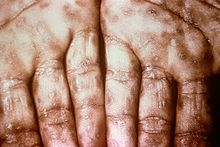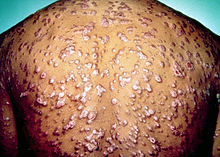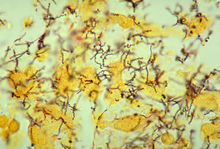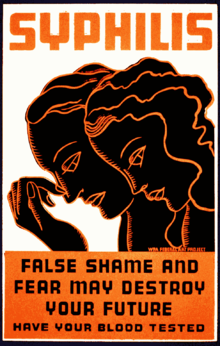- Syphilis
-
Syphilis Classification and external resources 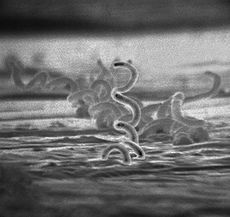
Electron micrograph of Treponema pallidumICD-10 A50-A53 ICD-9 090-097 DiseasesDB 29054 MedlinePlus 001327 eMedicine med/2224 emerg/563 derm/413 MeSH D013587 Syphilis is a sexually transmitted infection caused by the spirochete bacterium Treponema pallidum subspecies pallidum. The primary route of transmission is through sexual contact; however, it may also be transmitted from mother to fetus during pregnancy or at birth, resulting in congenital syphilis. Other human diseases caused by related Treponema pallidum include yaws (subspecies pertenue), pinta (subspecies carateum) and bejel (subspecies endemicum).
The signs and symptoms of syphilis vary depending in which of the four stages it presents (primary, secondary, latent, and tertiary). The primary stage classically presents with a single chancre (a firm, painless, non-itchy skin ulceration), secondary syphilis with a diffuse rash which frequently involves the palms of the hands and soles of the feet, latent syphilis with little to no symptoms, and tertiary syphilis with gummas, neurological, or cardiac symptoms. It has, however, been known as "the great imitator" due to its frequent atypical presentations. Diagnosis is usually via blood tests; however, the bacteria can also be visualized under a microscope. Syphilis can be effectively treated with antibiotics, specifically intramuscular penicillin G, and in those who are allergic, ceftriaxone is recommended.
Syphilis is believed to have infected 12 million people worldwide in 1999, with greater than 90% of cases in the developing world. After decreasing dramatically since the widespread availability of penicillin in 1940s, rates of infection have increased since the turn of the millennium in many countries, often in combination with human immunodeficiency virus (HIV). This has been attributed partly to risky sexual practices including multiple sexual partners and lack of barrier protection. Higher risk populations include men who have sex with men and sex workers.[citation needed]
Contents
Signs and symptoms
Syphilis can present in one of four different stages: primary, secondary, latent, and tertiary,[1] and may also occur congenitally.[2] It was referred to as "the great imitator" by Sir William Osler due to its varied presentations.[1][3]
Primary
 Primary chancre of syphilis on the hand
Primary chancre of syphilis on the hand
Primary syphilis is typically acquired by direct sexual contact with the infectious lesions of another person.[4] Approximately three to 90 days after the initial exposure (average 21 days) a skin lesion, called a chancre, appears at the point of contact.[1] This is classically (40% of the time) a single, firm, painless, non-itchy skin ulceration with a clean base and sharp borders between 0.3 and 3.0 cm in size.[1] The lesion, however, may take on almost any form.[5] In the classic form, it evolves from a macule to a papule and finally to an erosion or ulcer.[5] Occasionally, multiple lesions may be present (~40%),[1] with multiple lesions more common when coinfected with HIV. Lesions may be painful or tender (30%), and they may occur outside of the genitals (2–7%). The most common location in women is the cervix (44%), the penis in heterosexual men (99%), and anally and rectally relatively commonly in men who have sex with men (34%).[5] Lymph node enlargement frequently (80%) occurs around the area of infection,[1] occurring 7–10 days after chancre formation.[5] The lesion may persist for three to six weeks without treatment.[1]
Secondary
Secondary syphilis occurs approximately four to ten weeks after the primary infection.[1] While secondary disease is known for the many different ways it can manifest, symptoms most commonly involve the skin, mucus membranes, and lymph nodes.[6] There may be a symmetrical reddish-pink non-itchy rash on the trunk and extremities, including the palms and soles.[1][7] The rash may become maculopapular or pustular. It may form flat, broad, whitish, wart-like lesions known as condyloma latum on mucous membranes. All of these lesions are infectious harboring bacteria. Other symptoms may include fever, sore throat, malaise, weight loss, hair loss, and headache.[1] Rare manifestations include hepatitis, kidney disease, arthritis, periostitis, optic neuritis, uveitis, and interstitial keratitis.[1][8] The acute symptoms usually resolve after three to six weeks;[8] however, about 25% may present with a recurrence of secondary symptoms. Many people who present with secondary syphilis (40–85% of women, 20–65% of men) do not report previously having the classic chancre of primary syphilis.[6]
Latent
Latent syphilis is defined as having serologic proof of infection without symptoms of disease.[4] It is further described as either early (less than 1 year after secondary syphilis) or late (more than 1 year after secondary syphilis) in the United States.[8] The United Kingdom uses a cut-off of two years for early and late latent syphilis.[5] Early latent syphilis may have a relapse of symptoms. Late latent syphilis is asymptomatic, and not as contagious as early latent syphilis.[8]
Tertiary
Tertiary syphilis may occur approximately three to 15 years after the initial infection, and may be divided into three different forms: gummatous syphilis (15%), late neurosyphilis (6.5%), and cardiovascular syphilis (10%).[1][8] Without treatment, a third of infected people develop tertiary disease.[8] People with tertiary syphilis are not infectious.[1]
Gummatous syphilis or late benign syphilis usually occurs one to 46 years after the initial infection, with an average of 15 years. This stage is characterized by the formation of chronic gummas, which are soft, tumor-like balls of inflammation which may vary considerably in size. They typically affect the skin, bone, and liver, but can occur anywhere.[1]
Neurosyphilis refers to an infection involving the central nervous system. It may occur early, being either asymptomatic or in the form of syphilitic meningitis, or late as meningovascular syphilis, general paresis, or tabes dorsalis, which is associated with poor balance and lightning pains in the lower extremities. Late neurosyphilis typically occurs four to 25 years after the initial infection. Meningovascular syphilis typically presents with apathy and seizure, and general paresis with dementia and tabes dorsalis.[1] Also, there may be Argyll Robertson pupils, which are bilateral small pupils that constrict when the person focuses on near objects, but do not constrict when exposed to bright light.
Cardiovascular syphilis usually occurs 10–30 years after the initial infection. The most common complication is syphilitic aortitis, which may result in aneurysm formation.[1]
Congenital
Congenital syphilis may occur during pregnancy or during birth. Two-thirds of syphilitic infants are born without symptoms. Common symptoms that then develop over the first couple years of life include: hepatosplenomegaly (70%), rash (70%), fever (40%), neurosyphylis (20%), and pneumonitis (20%). If untreated, late congenital syphilis may occur in 40%, including: saddle nose deformation, Higoumenakis sign, saber shin, or Clutton's joints among others.[9]
Cause
Bacteriology
Main article: Treponema pallidumTreponema pallidum subspecies pallidum is a spiral-shaped, Gram-negative, highly mobile bacterium.[5][10] Three other human diseases are caused by related Treponema pallidum, including yaws (subspecies pertenue), pinta (subspecies carateum) and bejel (subspecies endemicum).[1] Unlike subtype pallidum they do not cause neurological disease.[9] Humans are the only known natural reservoir for subspecies pallidum.[2] It is unable to survive without a host for more than a few days. This is due to its small genome (1.14 MDa) and thus its inability to make most of its macronutrients. It has a slow doubling time of greater than 30 hours.[5]
Transmission
Syphilis is transmitted primarily by sexual contact or during pregnancy from a mother to her fetus; the spirochaete is able to pass through intact mucous membranes or compromised skin.[1][2] It is thus transmissible by kissing, oral, vaginal, and anal sex.[1] Approximately 30 to 60% of those exposed to primary or secondary syphilis will get the disease.[8] Its infectivity is exemplified by the fact that an individual inoculated with only 57 organisms has a 50% chance of being infected.[5] Most (60%) of new cases in the United States occur in men who have sex with men. It can be transmitted via blood products. However, it is tested for in many countries and thus the risk is low. The risk of transmission from sharing needles appears limited.[1] Syphilis cannot be contracted through toilet seats, daily activities, hot tubs, or sharing eating utensils or clothing.[11]
Diagnosis
Syphilis is difficult to diagnose clinically early in its presentation.[5] Confirmation is either via blood tests or direct visual inspection using microscopy. Blood tests are more commonly used, as they are easier to perform.[1] Diagnostic tests are, however, unable to distinguish between the stages of the disease.[12]
Blood tests
Blood tests are divided into nontreponemal and treponemal tests.[5] Nontreponemal tests are used initially, and include venereal disease research laboratory (VDRL) and rapid plasma reagin tests. However, as these tests are occasionally false positives, confirmation is required with a treponemal test, such as treponemal pallidum particle agglutination (TPHA) or fluorescent treponemal antibody absorption test (FTA-Abs).[1] False positives on the nontreponemal tests can occur with some viral infections such as varicella and measles, as well as with lymphoma, tuberculosis, malaria, endocarditis, connective tissue disease, and pregnancy.[4] Treponemal antibody tests usually become positive two to five weeks after the initial infection.[5] Neurosyphilis is diagnosed by finding high numbers of leukocytes (predominately lymphocytes) and high protein levels in the cerebrospinal fluid in the setting of a known syphilis infection.[1][4]
Direct testing
Dark ground microscopy of serous fluid from a chancre may be used to make an immediate diagnosis. However, hospitals do not always have equipment or experienced staff members, whereas testing must be done within 10 minutes of acquiring the sample. Sensitivity has been reported to be nearly 80%, thus can only be used to confirm a diagnosis but not rule one out. Two other tests that can be carried out on a sample from the chancre are direct fluorescent antibody testing and nucleic acid amplification tests. Direct fluorescent testing uses antibodies tagged with fluorescein, which attach to specific syphilis proteins, while nucleic acid amplification uses techniques, such as the polymerase chain reaction, to detect the presence of specific syphilis genes. These tests are not as time-sensitive, as they do not require living bacteria to make the diagnosis.[5]
Prevention
As of 2010[update], there is no vaccine effective for prevention.[2] Abstinence from intimate physical contact with an infected person is effective at reducing the transmission of syphilis, as is the proper use of a latex condom. Condom use, however, does not completely eliminate the risk.[13][14] Thus, the Center for Disease Control and Prevention recommends a long-term, mutually monogamous relationship with an uninfected partner and the avoidance of substances such as alcohol and other drugs that increase risky sexual behavior.[15]
Congenital syphilis in the newborn can be prevented by screening mothers during early pregnancy and treating those who are infected.[16] The United States Preventive Services Task Force (USPSTF) strongly recommends universal screening of all pregnant women,[17] while the World Health Organization recommends all women be tested at their first antenatal visit and again in the third trimester.[18] If they are positive, they recommend their partners also be treated.[18] Congenital syphilis is, however, still common in the developing world, as many women do not receive antenatal care at all, and the antenatal care others do receive does not include screening,[16] and it still occasionally occurs in the developed world, as those most likely to acquire syphilis (through drug use, etc.) are least likely to receive care during pregnancy.[16] A number of measures to increase access to testing appear effective at reducing rates of congenital syphilis in low to middle income countries.[18]
Syphilis is a notifiable disease in many countries, including Canada,[19] the European Union,[20] and United States.[21] This means health care providers are required to notify public health authorities, which will then ideally provide partner notification to the person's partners. [22] Physicians may also encourage patients to send their partners to seek care.[23] The Center for Disease Control and Prevention recommends sexually active men who have sex with men are tested at least yearly.[24]
Treatment
Early infections
The first-choice treatment for uncomplicated syphilis remains a single dose of intramuscular penicillin G or a single dose of oral azithromycin.[25] Doxycycline and tetracycline are alternative choices; however, they cannot be used in pregnant women. Antibiotic resistance has developed to a number of agents, including macrolides, clindamycin, and rifampin.[2] Ceftriaxone, a third-generation cephalosporin antibiotic, may be as effective as penicillin-based treatment.[1]
Late infections
For neurosyphilis due to the poor penetration of penicillin G into the central nervous system, those affected are recommended to be given large doses of intravenous penicillin for a minimum of 10 days.[1][2] If a person is allergic, ceftriaxone may be used or penicillin desensitization attempted. Other late presentations may be treated with once-weekly intramuscular penicillin G for three weeks. If allergic, as in the case of early disease, doxycycline or tetracycline may be used, but for a longer duration. Treatment at this point will limit further progression, but has only slight effect on damage which has already occurred.[1]
Jarisch-Herxheimer reaction
One of the potential side effects of treatment is the Jarisch-Herxheimer reaction. It frequently starts within one hour and lasts for 24 hours, with symptoms of fever, muscles pains, headache, and tachycardia.[1] It is caused by cytokines released by the immune system in response to lipoproteins released from rupturing syphilis bacteria.[26]
Epidemiology
Main article: Epidemiology of syphilis Age-standardized death from syphilis per 100,000 inhabitants in 2004[27]
Age-standardized death from syphilis per 100,000 inhabitants in 2004[27] no data<3535-7070-105105-140140-175175-210210-245245-280280-315315-350350-500>500
no data<3535-7070-105105-140140-175175-210210-245245-280280-315315-350350-500>500Syphilis is believed to have infected 12 million people in 1999, with greater than 90% of cases in the developing world.[2] It affects between 700,000 and 1.6 million pregnacies a year, resulting in spontaneous abortions, stillbirths, and congenital syphilis. In sub-Saharan Africa, syphilis contributes to approximately 20% of perinatal deaths.[9] Rates are proportionally higher among intravenous drug users, those who are infected with HIV, and men who have sex with men.[28][29][30] In the United States, rates of syphilis as of 2007 were six times greater in men than women, while they were nearly equal in 1997.[31] African Americans accounted for almost half of all cases in 2010.[32]
Syphilis was very common is Europe during the 18th and 19th centuries. In the developed world during the early 20th century, infections declined rapidly with the widespread use of antibiotics, until the 1980s and 1990s.[10] Since the year 2000, rates of syphilis have been increasing in the USA, UK, Australia and Europe, primarily among men who have sex with men.[2] Rates of syphilis among American women have, however, remained stable during this time, and rates among UK women have increased, but at a rate less than that of men.[33] Increased rates among heterosexuals have occurred in China and Russia since the 1990s.[2] This has been attributed to unsafe sexual practices, such as sexual promiscuity, prostitution, and decreasing use of barrier protection.[2][34][33]
Untreated, it has a mortality of 8% to 58%, with a greater death rate in males.[1] The symptoms of syphilis have become less severe over the 19th and 20th centuries, in part due to widespread availability of effective treatment and partly due to decreasing virulence of the spirochaete.[6] With early treatment, few complications result.[5] Syphilis increases the risk of HIV transmission by two to five times, and coinfection is common (30–60% in a number of urban centers).[1][2]
History
Main article: History of syphilis Portrait of Gerard de Lairesse by Rembrandt van Rijn, ca. 1665–67, oil on canvas. De Lairesse, himself a painter and art theorist, suffered from congenital syphilis that severely deformed his face and eventually blinded him.[35]
Portrait of Gerard de Lairesse by Rembrandt van Rijn, ca. 1665–67, oil on canvas. De Lairesse, himself a painter and art theorist, suffered from congenital syphilis that severely deformed his face and eventually blinded him.[35]
The exact origin of syphilis is unknown.[1] Of two primary hypotheses, one proposes syphilis was carried to Europe by the returning crewmen from Christopher Columbus's voyage to the Americas, the other proposes syphilis existed in Europe previously, but went unrecognized. These are referred to as the "Columbian" and "pre-Columbian" hypotheses respectively.[12] The Columbian hypothesis is best supported by the available evidence.[36] The first written records of an outbreak of syphilis in Europe occurred in 1494/1495 in Naples, Italy, during a French invasion.[10][12] Due to it being spread by returning French troops, it was initially known as the “French disease”. It is only in 1530 that the name "syphilis" was first used by the Italian physician and poet Girolamo Fracastoro as the title of his Latin poem in dactylic hexameter describing the ravages of the disease in Italy.[37] It was also known historically as the "Great Pox".[38][39]
The causative organism, Treponema pallidum, was first identified by Fritz Schaudinn and Erich Hoffmann in 1905.[10] The first effective treatment (Salvarsan) was developed in 1910 by Paul Ehrlich, which was followed by trials of penicillin and confirmation of its effectiveness in 1943.[10][38] Before the advent of effective treatment, mercury and isolation were commonly used, with treatments often worse than the disease.[38] Many famous historical figures, including Franz Schubert, Arthur Schopenhauer, Édouard Manet[10] and Adolf Hitler,[40] are believed to have had the disease.
Society and culture
Arts and literature
 Moll dies of syphillis, Hogarth's A Harlot's Progress
Moll dies of syphillis, Hogarth's A Harlot's Progress
The earliest Europe work of art to depict syphilis is Albrecht Dürer's Syphilitic Man, a wood cutting believed to represent a Landsknecht, a Northern European mercenary.[41] The myth of the femme fatale or "poison women" of the 19th century is believed to be partly derived from the devastation of syphilis, with classic examples in literature including John Keats' La Belle Dame sans Merci.[42][43]
The artist Jan van der Straet painted a scene of a wealthy man receiving treatment for syphilis with the tropical wood guaiacum sometime around 1580.[44] The title of the work is "Preparation and Use of Guayaco for Treating Syphilis". That the artist chose to include this image in a series of works celebrating the New World indicates how important a treatment, however ineffective, for syphilis was to the European elite at that time. The richly colored and detailed work depicts four servants preparing the concoction while a physician looks on, hiding something behind his back while the hapless patient drinks.[45]
Tuskegee and Guatemala studies
See also: Tuskegee syphilis experiment and Syphilis experiments in GuatemalaOne of the most infamous United States cases of questionable medical ethics in the 20th century was the Tuskegee syphilis study.[46] The study took place in Tuskegee, Alabama, and was supported by the U.S. Public Health Service (PHS) in partnership with the Tuskegee Institute.[47] The study began in 1932, when syphilis was a widespread problem and there was no safe and effective treatment.[3] The study was designed to measure the progression of untreated syphilis. By 1947, penicillin had been validated as an effective cure for syphilis and was becoming widely used to treat the disease. Study directors, however, continued the study and did not offer the participants treatment with penicillin.[47] This is debated, and some have found that penicillin was given to many of the subjects.[3] The study did not end until 1972.[47]
Syphilis experiments were also carried out in Guatemala from 1946 to 1948. They were United States-sponsored human experiments, conducted during the government of Juan José Arévalo with the cooperation of some Guatemalan health ministries and officials. Doctors infected soldiers, prisoners, and mental patients with syphilis and other sexually transmitted diseases, without the informed consent of the subjects, and then treated them with antibiotics. In October 2010, the U.S. formally apologized to Guatemala for conducting these experiments.[48]
References
- ^ a b c d e f g h i j k l m n o p q r s t u v w x y z aa ab ac ad Kent ME, Romanelli F (February 2008). "Reexamining syphilis: an update on epidemiology, clinical manifestations, and management". Ann Pharmacother 42 (2): 226–36. doi:10.1345/aph.1K086. PMID 18212261.
- ^ a b c d e f g h i j k Stamm LV (February 2010). "Global challenge of antibiotic-resistant Treponema pallidum". Antimicrob. Agents Chemother. 54 (2): 583–9. doi:10.1128/AAC.01095-09. PMC 2812177. PMID 19805553. http://www.pubmedcentral.nih.gov/articlerender.fcgi?tool=pmcentrez&artid=2812177.
- ^ a b c White, RM (2000-03-13). "Unraveling the Tuskegee Study of Untreated Syphilis.". Archives of internal medicine 160 (5): 585–98. doi:10.1001/archinte.160.5.585. PMID 10724044.
- ^ a b c d al.], Committee on Infectious Diseases, American Academy of Pediatrics ; Larry K. Pickering, editor ... [et (2006). Red book 2006 Report of the Committee on Infectious Diseases (27th ed.). Elk Grove Village, IL: American Academy of Pediatrics. pp. 631–44. ISBN 9781581102079.
- ^ a b c d e f g h i j k l m Eccleston, K; Collins, L, Higgins, SP (2008 Mar). "Primary syphilis.". International journal of STD & AIDS 19 (3): 145–51. PMID 18397550.
- ^ a b c Mullooly, C; Higgins, SP (2010 Aug). "Secondary syphilis: the classical triad of skin rash, mucosal ulceration and lymphadenopathy.". International journal of STD & AIDS 21 (8): 537–45. PMID 20975084.
- ^ Dylewski J, Duong M (2 January 2007). "The rash of secondary syphilis". Canadian Medical Association Journal 176 (1): 33–5. doi:10.1503/cmaj.060665. PMC 1764588. PMID 17200385. http://www.pubmedcentral.nih.gov/articlerender.fcgi?tool=pmcentrez&artid=1764588.
- ^ a b c d e f g Bhatti MT (2007). "Optic neuropathy from viruses and spirochetes". Int Ophthalmol Clin 47 (4): 37–66, ix. doi:10.1097/IIO.0b013e318157202d. PMID 18049280.
- ^ a b c Woods CR (June 2009). "Congenital syphilis-persisting pestilence". Pediatr. Infect. Dis. J. 28 (6): 536–7. doi:10.1097/INF.0b013e3181ac8a69. PMID 19483520.
- ^ a b c d e f Franzen, C (2008 Dec). "Syphilis in composers and musicians--Mozart, Beethoven, Paganini, Schubert, Schumann, Smetana.". European Journal of Clinical Microbiology and Infectious Diseases 27 (12): 1151–7. PMID 18592279.
- ^ "Syphilis - CDC Fact Sheet". Centers for Disease Control and Prevention (CDC). 16 September 2010. http://www.cdc.gov/std/syphilis/STDFact-Syphilis.htm. Retrieved 2007-05-30.
- ^ a b c Farhi, D; Dupin, N (2010 Sep-Oct). "Origins of syphilis and management in the immunocompetent patient: facts and controversies.". Clinics in dermatology 28 (5): 533–8. PMID 20797514.
- ^ Koss CA, Dunne EF, Warner L (July 2009). "A systematic review of epidemiologic studies assessing condom use and risk of syphilis". Sex Transm Dis 36 (7): 401–5. doi:10.1097/OLQ.0b013e3181a396eb. PMID 19455075.
- ^ "How can syphilis be prevented?". Centers for Disease Control and Prevention (CDC).
- ^ "Syphilis - CDC Fact Sheet". Center for Disease Control and Prevention. http://www.cdc.gov/std/syphilis/stdfact-syphilis.htm. Retrieved 2 August 2011.
- ^ a b c Schmid, G (2004 Jun). "Economic and programmatic aspects of congenital syphilis prevention.". Bulletin of the World Health Organization 82 (6): 402–9. PMID 15356931.
- ^ U.S. Preventive Services Task, Force (2009 May 19). "Screening for syphilis infection in pregnancy: U.S. Preventive Services Task Force reaffirmation recommendation statement.". Annals of internal medicine 150 (10): 705–9. PMID 19451577.
- ^ a b c Hawkes, S; Matin, N, Broutet, N, Low, N (2011 Jun 15). "Effectiveness of interventions to improve screening for syphilis in pregnancy: a systematic review and meta-analysis.". The Lancet infectious diseases. PMID 21683653.
- ^ "Notifiable Diseases On-Line". Public Health Agency of Canada. http://dsol-smed.phac-aspc.gc.ca/dsol-smed/ndis/list-eng.php. Retrieved 2 August 2011.
- ^ Viñals-Iglesias, H; Chimenos-Küstner, E (2009 Sep 1). "The reappearance of a forgotten disease in the oral cavity: syphilis.". Medicina oral, patologia oral y cirugia bucal 14 (9): e416-20. PMID 19415060.
- ^ "Table 6.5. Infectious Diseases Designated as Notifiable at the National Level-United States, 2009 [a"]. Red Book. http://www.unboundmedicine.com/redbook/ub/view/RedBook/187389/all/Table_6_5__Infectious_Diseases_Designated_as_Notifiable_at_the_National_Level_United_States__2009_%5Ba%5D. Retrieved 2 August 2011.
- ^ Brunner & Suddarth's textbook of medical-surgical nursing. (12th ed. ed.). Philadelphia: Wolters Kluwer Health/Lippincott Williams & Wilkins. 2010. pp. 2144. ISBN 9780781785891. http://books.google.com/books?id=SmtjSD1x688C&pg=PA2144.
- ^ Hogben, M (2007 Apr 1). "Partner notification for sexually transmitted diseases.". Clinical infectious diseases: an official publication of the Infectious Diseases Society of America 44 Suppl 3: S160-74. PMID 17342669.
- ^ "Trends in Sexually Transmitted Diseases in the United States: 2009 National Data for Gonorrhea, Chlamydia and Syphilis". Center for Disease Control and Prevention. http://www.cdc.gov/std/stats09/tables/trends-table.htm. Retrieved 3 August 2011.
- ^ al.], David N. Gilbert ... [et. The Sanford guide to antimicrobial therapy 2011. Sperryville, VA: Antimicrobial Therapy, Inc.. pp. 22. ISBN 9781930808652.
- ^ Radolf, JD; Lukehart SA (editors) (2006). Pathogenic Treponema: Molecular and Cellular Biology. Caister Academic Press. ISBN 1-904455-10-7.
- ^ "WHO Disease and injury country estimates". World Health Organization (WHO). 2004. http://www.who.int/healthinfo/global_burden_disease/estimates_country/en/index.html. Retrieved 11 November 2009.
- ^ Coffin, LS; Newberry, A, Hagan, H, Cleland, CM, Des Jarlais, DC, Perlman, DC (2010 Jan). "Syphilis in drug users in low and middle income countries.". The International journal on drug policy 21 (1): 20–7. PMID 19361976.
- ^ Gao, L; Zhang, L, Jin, Q (2009 Sep). "Meta-analysis: prevalence of HIV infection and syphilis among MSM in China.". Sexually transmitted infections 85 (5): 354–8. PMID 19351623.
- ^ Karp, G; Schlaeffer, F, Jotkowitz, A, Riesenberg, K (2009 Jan). "Syphilis and HIV co-infection.". European journal of internal medicine 20 (1): 9–13. PMID 19237085.
- ^ "Trends in Reportable Sexually Transmitted Diseases in the United States, 2007". Center for Disease Control and Prevention. http://www.cdc.gov/std/stats07/trends.htm. Retrieved 2 August 2011.
- ^ "STD Trends in the United States: 2010 National Data for Gonorrhea, Chlamydia, and Syphilis". Center for Disease Control and Prevention. http://www.cdc.gov/std/stats10/tables/trends-table.htm. Retrieved 20 November 2011.
- ^ a b Kent, ME; Romanelli, F (2008 Feb). "Reexamining syphilis: an update on epidemiology, clinical manifestations, and management.". The Annals of pharmacotherapy 42 (2): 226–36. doi:10.1345/aph.1K086. PMID 18212261.
- ^ Ficarra, G; Carlos, R (2009 Sep). "Syphilis: the renaissance of an old disease with oral implications.". Head and neck pathology 3 (3): 195–206. PMID 20596972.
- ^ The Metropolitan Museum of Art Bulletin, Summer 2007, pp. 55–56.
- ^ Rothschild, BM (2005-05-15). "History of syphilis.". Clinical infectious diseases: an official publication of the Infectious Diseases Society of America 40 (10): 1454–63. PMID 15844068.
- ^ Nancy G. "Siraisi, Drugs and Diseases: New World Biology and Old World Learning," in Anthony Grafton, Nancy G. Siraisi, with April Shelton, eds., New World, Ancient Texts (Cambridge MA: Belknap Press/Harvard University Press, 1992), 159-94
- ^ a b c Dayan, L; Ooi, C (2005 Oct). "Syphilis treatment: old and new.". Expert opinion on pharmacotherapy 6 (13): 2271–80. PMID 16218887.
- ^ Knell, RJ (2004-05-07). "Syphilis in renaissance Europe: rapid evolution of an introduced sexually transmitted disease?". Proceedings. Biological sciences / The Royal Society 271 Suppl 4: S174-6. doi:10.1098/rsbl.2003.0131. PMC 1810019. PMID 15252975. http://www.pubmedcentral.nih.gov/articlerender.fcgi?tool=pmcentrez&artid=1810019.
- ^ Hitler syphilis theory revived BBC News March 12, 2003
- ^ Eisler, CT (2009 Winter). "Who is Dürer's "Syphilitic Man"?". Perspectives in biology and medicine 52 (1): 48–60. PMID 19168944.
- ^ Hughes, Robert (2007). Things I didn't know : a memoir (1st Vintage Book ed. ed.). New York: Vintage. pp. 346. ISBN 9780307385987.
- ^ Wilson, [ed]: Joanne Entwistle, Elizabeth (2005). Body dressing ([Online-Ausg.] ed.). Oxford: Berg Publishers. pp. 205. ISBN 9781859734445.
- ^ Reid, Basil A. (2009). Myths and realities of Caribbean history ([Online-Ausg.] ed.). Tuscaloosa: University of Alabama Press. pp. 113. ISBN 9780817355340. http://books.google.com/books?id=KtT0_P-9xiAC&pg=PA113.
- ^ Jan van der Straet's "Preparation..." at commercial art site. Retrieved 6 August 2007.
- ^ Katz RV, Kegeles SS, Kressin NR, et al. (November 2006). "The Tuskegee Legacy Project: willingness of minorities to participate in biomedical research". J Health Care Poor Underserved 17 (4): 698–715. doi:10.1353/hpu.2006.0126. PMC 1780164. PMID 17242525. http://muse.jhu.edu/cgi-bin/resolve_openurl.cgi?issn=1049-2089&volume=17&issue=4&spage=698&aulast=Katz.
- ^ a b c "U.S. Public Health Service Syphilis Study at Tuskegee". Centers for Disease Control and Prevention (CDC). http://www.cdc.gov/tuskegee/timeline.htm. Retrieved 2010-07-07.
- ^ "U.S. apologizes for newly revealed syphilis experiments done in Guatemala". The Washington Post. 1 October 2010. http://www.washingtonpost.com/wp-dyn/content/article/2010/10/01/AR2010100104457.html. Retrieved 1 October 2010. "The United States issued an unusual apology Friday to Guatemala for conducting experiments in the 1940s in which doctors infected soldiers, prisoners and mental patients with syphilis and other sexually transmitted diseases."
Further reading
- Parascandola, John. Sex, Sin, and Science: A History of Syphilis in America (Praeger, 2008) 195 pp. ISBN 978-0-275-99430-3 excerpt and text search
- Shmaefsky, Brian, Hilary Babcock and David L. Heymann. Syphilis (Deadly Diseases & Epidemics) (2009)
- Stein, Claudia. Negotiating the French Pox in Early Modern Germany (2009)
External links
- "Syphilis - CDC Fact Sheet" Centers for Disease Control and Prevention (CDC)
- UCSF HIV InSite Knowledge Base Chapter: Syphilis and HIV
Sexually transmitted diseases and infections (STD/STI) (primarily A50–A64, 090–099) Bacterial Chancroid (Haemophilus ducreyi) · Chlamydia/Lymphogranuloma venereum (Chlamydia trachomatis) · Donovanosis or Granuloma Inguinale (Klebsiella granulomatis) · Gonorrhea (Neisseria gonorrhoeae) · Syphilis (Treponema pallidum) · Ureaplasma infection (Ureaplasma urealyticum)Protozoal Parasitic Viral AIDS (HIV-1/HIV-2) · Cervical cancer, vulvar cancer & Genital warts (condyloma), Penile cancer, Anal cancer (Human papillomavirus (HPV)) · Hepatitis B (Hepatitis B virus) · Herpes simplex (HSV1/HSV2) · Molluscum contagiosum (MCV)General
inflammationInfectious diseases · Bacterial diseases: BV4 non-proteobacterial G- (primarily A00–A79, 001–041, 080–109) Spirochaete TreponemaBorrelia recurrentis (Louse borne relapsing fever) · Borrelia hermsii/Borrelia duttoni/Borrelia parkeri (Tick borne relapsing fever)LeptospiraceaeLeptospira interrogans (Leptospirosis)SpirillaceaeSpirillum minus (Rat-bite fever/Sodoku)Chlamydiaceae Bacteroidetes Bacteroides fragilis · Bacteroides forsythus · Capnocytophaga canimorsus · Porphyromonas gingivalis · Prevotella intermediaFusobacteria Fusobacterium necrophorum (Lemierre's syndrome) · Fusobacterium nucleatum · Fusobacterium polymorphumStreptobacillus moniliformis (Rat-bite fever/Haverhill fever)Diseases of maternal transmission / perinatal infection / vertical transmission (P35–P39, 771) Gestational/
transplacental/TORCH complexvirus (Congenital rubella syndrome, Congenital cytomegalovirus infection, Neonatal herpes simplex) · Hepatitis B · Congenital varicella syndrome · HIV · Fifth diseasebacteria (Congenital syphilis)other (Toxoplasmosis)Transmissible at birth/
transcervicalCell-mediated immunodeficiency
of late pregnancyBreastfeeding Categories:- Bacterial diseases
- Bacterium-related cutaneous conditions
- Infections with a predominantly sexual mode of transmission
- Spirochaetes
Wikimedia Foundation. 2010.

